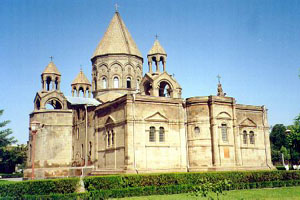
Some linguists have found an evidence of this supposed ancient relationship between Basques and Caucasians in other country of the Caucasian region: Armenia.
Prof Vahan Sarkissian (Erevan University), who was appointed as Hounorary Academic Member by the Academy of the Basque Language in 2002, found numerous lexical and grammatical similarities between Armenian and Euskara, what led him to support the Basque-Armenian theory. This was already supported by the British Edward Spencer Dodgson (19th century), as well as the German Joseph  Karst (20th century).
Karst (20th century).
The hypothesis considers that both Armenian and Basque took part of an ancient group of pre-Indo-European languages that became geographically isolated, due to the passage of time and the arrival of other peoples in Europe with their respective languages. The distance between them could also be due to a prehistoric migration from the Pyrenees to the Caucasus or the other way round.
The fact of that the Armenian language has been commonly classified as Indo-European makes any link with a pre-Indo-European language like Basque be a priori impossible. However, Vahan Sarkissian did not agree with this Indo-European classification of Armenian since he considers that the great amount of vocabulary of Indo-European origin that is present in the language (what allowed the above-mentioned classification) is due to a millennial relationship with neighbouring peoples of Iranian language. Regarding grammar or other linguistic facets, Armenian is more linked with Euskara than any other language, according to Vahan Sarkissian.
The similarities between Euskara and Armenian go beyond the lexical resemblance for Sarkissian, who underlined the phonetic similarity among other features. The inability of Basques and Armenians to pronounce an '-r' at the beginning of the word is another characteristic, as well as the tendency of not to accumulate more than a consonant, which is very common in the Caucasian languages like Georgian. In the grammatical field, Sarkissian noted the absence of word gender in both languages, the positioning of the article after the word as well as the usage of the same desinence to build the plural form (-k) in both Euskara and Eastern Armenian. He also emphasised the great toponymic similarity between both languages.
In order to improve the knowledge about the Basque-Armenian theory, Sarkissian proposed the challenge of acquiring the Proto-Basque and Proto-Armenian languages, which would be free of Latin and Iranian influences, so that the experts can get to know the original Basque-Armenian language.

